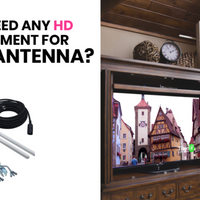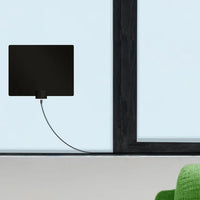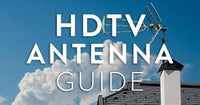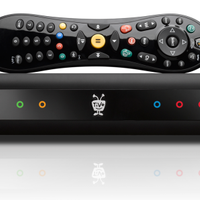Are you experiencing frustrating TV antenna and reception issues? From poor signal strength to interference from nearby devices, these problems can hinder your viewing experience. In this comprehensive guide, we will delve into common antenna issues, ways to improve TV reception, the role of antenna splitters, Unlimited Antennas, and VHF antennas. By the end of this article, you'll be equipped with expert advice to troubleshoot and enhance your TV antenna setup.
What Are the Common Issues with TV Antennas?
When it comes to TV antennas, several issues can affect your viewing quality. Interference from nearby devices can disrupt your TV signal, leading to a blurry or pixelated screen. Poor signal strength is another common problem that can result in channels cutting in and out. Incorrect antenna placement, such as positioning it too close to electronic devices, can also impact reception negatively. Additionally, the type of antenna you have can make a big difference in the quality of your TV signal. Indoor antennas are usually smaller and less powerful, so they may struggle to pick up weaker signals from farther away. Outdoor antennas, on the other hand, are typically larger and mounted higher up, making them more effective at capturing signals.
To improve your TV antenna reception, try relocating your antenna to a higher position, away from any electronic devices that could be causing interference. You may also want to consider upgrading to a higher-quality antenna that is better suited to your location and signal strength.
If you continue to experience issues with your TV antenna, it may be helpful to consult with a professional installer or technician who can assess your setup and recommend the best solution for improving your reception. By addressing these common issues, you can enjoy clear, uninterrupted TV viewing without any frustrating interruptions.
Interference from Nearby Devices
One of the most common issues affecting TV antenna reception is interference from nearby devices. Electronic gadgets, appliances, and even wiring can emit signals that interfere with the TV signal, causing disruptions in your viewing experience. To minimize interference, try moving your TV antenna away from other electronic devices or appliances. You can also try using a signal amplifier or a high-quality coaxial cable to boost the signal strength. Additionally, make sure your antenna is properly installed and pointing in the right direction towards the broadcast towers.
Another common issue is poor signal strength due to obstacles such as buildings, trees, or hills blocking the signal. In this case, try repositioning your antenna to a higher location or consider investing in a rooftop or Unlimited Antenna for better reception.
Weather conditions can also affect TV antenna reception, especially during severe thunderstorms or heavy rain. In such cases, it's best to wait for the weather to clear up before attempting to fix the issue.
If you're still experiencing issues with your TV antenna reception, consider contacting a professional antenna installer for help. They can assess your setup and recommend the best solutions for improving your signal strength and overall viewing experience.
Poor Signal Strength
A weak TV signal can manifest in fuzzy images, audio dropouts, or complete channel loss. Factors such as distance from broadcast towers, obstacles in the signal's line of sight, and antenna quality can contribute to poor signal strength. Other factors that can weaken a TV signal include interference from other electronic devices, weather conditions like heavy rain or snow, and electrical interference from power lines or other sources.
Tips for improving a weak TV signal include adjusting the antenna position to get better line of sight to the broadcast tower, upgrading to a higher quality antenna, avoiding placing the antenna near other electronic devices that can cause interference, and ensuring all cables and connections are secure and in good condition.
In some cases, a signal booster or amplifier may be necessary to strengthen the TV signal. Alternatively, subscribing to a cable or satellite TV service can provide a more reliable signal, as these services are not affected by distance or obstacles like broadcast TV signals are.
Incorrect Antenna Placement
Placing your antenna in the wrong location can significantly impact reception quality. The height of the antenna, its distance from electronic devices, and the direction it faces are crucial factors to consider for optimal performance. For example, placing your antenna too close to electronic devices such as TVs, computers, or smartphones can cause interference and result in poor signal reception. Similarly, if the antenna is located too low to the ground or obstructed by buildings or trees, it may not be able to pick up signals effectively.
To ensure the best reception quality, it is recommended to place the antenna in a high and open location, away from any potential sources of interference. Additionally, pointing the antenna in the direction of the broadcast towers can help improve signal strength.
It is also important to regularly check and adjust the position of the antenna as needed to maintain optimal reception quality. By paying attention to these factors and optimizing the placement of your antenna, you can enjoy clear and reliable TV or radio signals.
How Can I Improve TV Reception with an Antenna?
If you're struggling with poor TV reception, there are several strategies to enhance your antenna setup. Installing an amplifier can boost weak signals, especially in areas with obstacles or long distances from broadcast towers. Choosing the right antenna for your location, such as an outdoor or directional antenna, can also improve reception quality. Additionally, adjusting the positioning and angle of your antenna can make a big difference. Try experimenting with different heights and directions to find the best signal. It's also important to make sure your antenna is properly grounded to prevent interference.
If you're still having trouble, consider investing in a digital converter box or subscribing to a streaming service for access to more channels. And don't forget to regularly scan for channels and keep your equipment up to date.
Installing an Amplifier
An amplifier, also known as a signal booster, can amplify weak TV signals, enhancing reception quality. By strategically placing the amplifier in your setup, you can overcome signal loss due to long cable runs or interference. Amplifiers come in various types, including indoor amplifiers that are placed near your TV or outdoor amplifiers mounted on an antenna mast. They can typically increase signal strength by up to 15 decibels, improving picture and sound quality for your television.
When installing an amplifier, it's important to follow the manufacturer's instructions carefully to ensure proper setup and optimal performance. Additionally, consider factors such as the distance between the amplifier and your TV, as well as potential sources of interference that could impact signal quality.
Amplifiers can be a valuable tool for enhancing your TV viewing experience by boosting weak signals and improving reception quality. Whether you're dealing with pixelated images, ghosting, or poor sound, adding an amplifier to your setup can help resolve these issues and provide a clearer, more enjoyable viewing experience.
Choosing the Right Antenna for Your Location
Each location has its unique challenges when it comes to TV reception. Understanding the broadcast towers' locations and the signal frequencies they use can help you select the most suitable antenna type for optimal reception. Factors such as terrain, building materials, and surrounding interference should guide your antenna choice. For example, if you live in a rural area with a lot of trees or hills blocking the signal from reaching your home, you may need a more powerful outdoor antenna with a higher gain to pick up distant signals. On the other hand, if you are in an urban area with a lot of buildings or other obstructions, a multi-directional antenna may be more appropriate to pick up signals from multiple directions.

Additionally, the frequency bands used by different TV stations can also impact your antenna selection. VHF channels (2-13) require longer antenna elements than UHF channels (14-51), so it's important to choose an antenna that is optimized for the frequencies of the channels you want to receive.
Lastly, interference from other electronic devices, such as Wi-Fi routers or cell phone towers, can also affect your TV reception. In these cases, a specially shielded antenna or a signal amplifier may be necessary to improve your signal quality.
Ultimately, by considering all these factors and doing some research on the broadcast towers in your area, you can make an informed decision on the best TV antenna for your location to ensure optimal reception of your favorite channels.
Optimizing Signal by Adjusting Antenna Direction
Adjusting the direction of your antenna is a simple yet effective way to improve TV reception. By pointing your antenna towards broadcast towers and ensuring a clear line of sight, you can maximize signal strength and minimize interference.
What Role Does an Antenna Splitter Play in TV Reception?
Antenna splitters are commonly used to split a single antenna signal for multiple TVs. However, improper use of splitters can lead to signal loss and degraded reception quality. Understanding how splitters work and their impact on signal distribution is essential for maintaining optimal TV reception. An antenna splitter is a device that divides a single incoming signal into multiple outputs, allowing multiple devices to receive the same signal simultaneously. However, each time a signal is split, there is a loss of signal strength. This loss is referred to as insertion loss and is typically measured in decibels (dB).
When using an antenna splitter, it is important to choose a splitter with the appropriate number of outputs for your setup. For example, if you need to split a signal for two TVs, you should use a two-way splitter. Using a splitter with more outputs than necessary can result in greater signal loss.
In addition to insertion loss, signal degradation can also occur if the splitter is of poor quality or not properly installed. Using a high-quality, properly shielded splitter can help minimize signal loss and maintain reception quality. It is also important to ensure that all connections are secure and that the splitter is properly grounded.
To minimize signal loss when using an antenna splitter, consider using a signal amplifier in conjunction with the splitter. A signal amplifier can help boost the strength of the signal before it is split, compensating for the loss that occurs during splitting.
Overall, understanding how antenna splitters work and taking proper precautions when using them can help maintain optimal TV reception quality. By choosing the right splitter, ensuring proper installation, and considering the use of a signal amplifier, you can minimize signal loss and ensure clear, reliable reception for all of your devices.
Understanding Signal Loss with Splitters
Splitting a TV signal using a splitter can introduce signal loss, resulting in weaker signals reaching your TVs. Using high-quality splitters and minimizing the number of splits can help reduce signal degradation and improve reception. To minimize signal loss, consider using a high-quality splitter with minimal loss ratings. Look for splitters with low insertion loss, which means that they will have less impact on the signal strength as it is split. Additionally, try to limit the number of splits in your setup. The more splits that are made, the more the signal will weaken as it travels to each TV.
Another way to improve reception is to make sure that your cables and connectors are in good condition. Check for any damage or wear and tear that could be affecting the signal quality. Also, consider using signal amplifiers or boosters to strengthen the signal before it is split.
If you are experiencing poor reception on one or more of your TVs, you may need to adjust the positioning of your antenna or consider investing in a stronger antenna to capture more signal. Additionally, make sure that your TVs and devices are properly tuned and configured to receive the signals being transmitted.
By using high-quality equipment, minimizing splits, and optimizing your setup, you can reduce signal loss and improve the overall reception on your TVs.
Properly Installing and Using a Splitter
Correct installation of a splitter involves connecting it to the main antenna feed and routing the split signals to individual TVs. Ensuring tight connections, proper cable lengths, and using compatible cables are crucial for maximizing signal quality and avoiding reception issues. It is important to choose a high-quality splitter that is compatible with the type of signal being distributed (such as analog or digital). The splitter should also be able to handle the number of outputs required for the setup.
When installing the splitter, make sure to disconnect the main antenna feed from the TV and connect it to the input port of the splitter. Then, connect the output ports of the splitter to the individual TVs using coaxial cables.
To optimize signal quality, use short cable lengths and make sure all connections are tight and secure. Avoid using cheap or damaged cables, as this can lead to signal loss and poor reception.
Finally, test the signal on each TV to ensure that the splitter is distributing the signal effectively. Adjust the connections if needed to improve reception quality.
Considering a Signal Booster with a Splitter
Combining a signal booster with a splitter can counteract signal loss associated with splitting. By amplifying the split signals before they reach the TVs, you can maintain strong reception across all connected devices. Additionally, using a signal booster can help improve the overall signal strength in your home, leading to clearer picture quality and better sound on your TVs. This can be especially beneficial if you live in an area with weak signal reception or if your home has multiple floors or thick walls that can interfere with signal transmission.
Combining a signal booster with a splitter can help ensure that you get the best possible signal quality on all of your TVs, leading to a more enjoyable viewing experience for you and your family.
Is an Unlimited Antenna a Better Option for Improved Reception?
Installing an antenna in the attic presents a viable solution for improving TV reception in certain scenarios. Unlimited Antennas offer advantages such as protection from external elements and better signal reception due to increased elevation. However, several factors need to be considered before opting for an Unlimited Antenna.
Advantages of Installing an Antenna in the Attic
An Unlimited Antenna is shielded from weather conditions, reducing wear and tear on the equipment. The elevated location can also provide a clearer line of sight to broadcast towers, resulting in enhanced signal reception compared to indoor setups.
Factors to Consider Before Choosing an Unlimited Antenna
Prior to installing an Unlimited Antenna, factors such as attic space, roof material, and proximity to broadcast towers should be evaluated. Ensuring proper mounting, grounding, and cable routing is essential for optimal performance and longevity of the antenna system.
Installation Tips for Unlimited Antennas
When installing an Unlimited Antenna, pay attention to its orientation towards broadcast towers, minimizing obstructions such as walls or metal objects. Testing signal strength and quality after installation can help fine-tune the antenna's position for the best reception results.
How Does a VHF Antenna Differ from Other Types?
VHF (Very High Frequency) antennas operate on a different frequency spectrum than UHF (Ultra High Frequency) antennas, catering to specific types of TV channels. Understanding the differences between VHF and UHF antennas can help you optimize your reception experience and troubleshoot any issues that may arise with VHF signals.
Understanding VHF and UHF Frequencies
VHF frequencies are lower on the spectrum and are typically used by network TV channels, while UHF frequencies are higher and are common for local stations. Selecting the appropriate antenna type based on the channels you watch can ensure optimal signal reception.
When to Opt for a VHF Antenna
If you predominantly watch VHF channels or experience reception issues with specific stations, investing in a VHF antenna may be necessary. VHF antennas are designed to capture signals on lower frequencies efficiently, providing clearer and more stable reception for VHF broadcasts.
Troubleshooting VHF Antenna Reception Issues
If you encounter problems with VHF antenna reception, factors such as antenna height, orientation, and interference sources should be examined. Adjusting the antenna position and testing signal strength can help identify and address issues affecting VHF signal reception.







